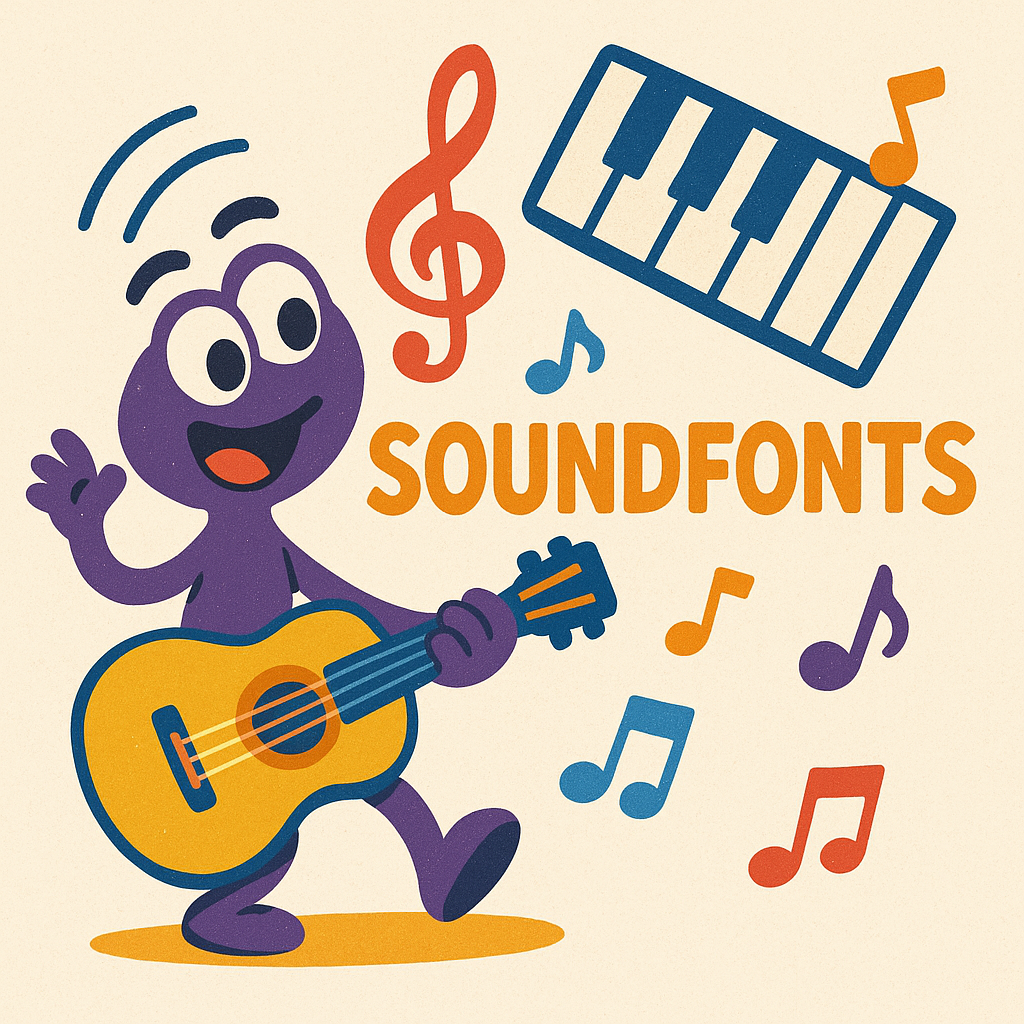When you work with MIDI, you’re essentially dealing with a digital score — notes, timing, velocity — but no sound. That’s where SoundFonts (usually .sf2 files) come in.
A SoundFont is like a virtual instrument library: a collection of samples (recorded or synthesized sounds) mapped across the keys of a keyboard, with envelopes, velocity layers, and modulation baked in. Think of it like fonts for text: same words, different look. With SoundFonts, it’s the same MIDI notes, but a completely different instrument vibe.
The SoundFont format dates back to the ‘90s (Creative Labs / E-Mu Systems) and became an open standard with version 2.0. Today, it’s still widely used because it’s lightweight, versatile, and plays nicely with both old-school MIDI tools and modern DAWs.
A Short History of SoundFonts
The SoundFont format was born in the early 1990s, developed by E-mu Systems and Creative Labs. At the time, Creative was dominating the PC audio market with its Sound Blaster sound cards.
- In 1994, Creative introduced the Sound Blaster AWE32, one of the first cards to support SoundFonts. Suddenly, PC musicians could load custom instrument banks instead of relying on fixed, built-in sounds.
- The format evolved into SoundFont 2.0, which became the de facto standard for many years. It was open enough that third-party tools and editors began to flourish.
- Throughout the late ‘90s and early 2000s, SoundFonts were a favorite of hobbyists and game composers because they were lightweight, portable, and surprisingly flexible.
- Even today, decades later,
.sf2files are still widely used in DAWs, MIDI players, and open-source projects — proof of how robust and practical the format turned out to be.
In many ways, SoundFonts were the “VSTs before VSTs” — the first time everyday musicians could swap out instrument banks and personalize their digital studio.
Why SoundFonts Still Matter
- Quick realism: Instantly turn MIDI sketches into something listenable without buying heavy VST libraries.
- Lightweight: Optimized for fast loading and real-time use. Perfect for prototyping or live settings.
- Flexibility: Swap sounds in seconds. Want that guitar part on a Rhodes instead? Just load a new SoundFont.
- DIY-friendly: Tools like Polyphone let you build and edit your own SoundFonts.
In mITyStudio, I use SoundFonts as “virtual session musicians.” They let me test out arrangements, swap instruments, or add layers of color — without breaking my flow.
What about GM banks?
If you’ve ever seen “GM” mentioned, that stands for General MIDI. It’s a standard set of 128 instruments (plus drums) defined back in the early ’90s so that MIDI files would play back the same way everywhere.
A GM bank is simply a SoundFont that implements that full set of instruments. A lightweight GM bank is a smaller, more resource-friendly version: fewer velocity layers, shorter samples, and a compact file size (often 10–50 MB instead of gigabytes).
These are perfect for quick sketching or prototyping in tools like mITyStudio. You can load any MIDI idea and immediately hear it with the right instruments. Later, you can swap individual parts for higher-quality SoundFonts or VSTs once you’ve locked in the arrangement.
Where to Find SoundFonts
The web is full of free and commercial SoundFonts. Some great starting points:
- ProducersBuzz – 900 Free SoundFonts
- RK Hive (winds, brass, etc.)
- Musical Artifacts (community-driven, search by instrument type)
- ZanderJaz – Guitar SoundFonts
- Free Drum Kits
- Polyphone (editor + community exchange)
The Legal Side of SoundFonts
Here’s where things get tricky. Just because you can download a SoundFont doesn’t mean you can use it freely.

Generally safe:
- SoundFonts explicitly released as royalty-free, public domain, or under a clear Creative Commons license.
- SoundFonts you’ve made yourself (recorded or synthesized samples).
- Libraries distributed with a license that allows commercial use.
Risky or outright illegal:
- “Ripped” SoundFonts — samples taken from commercial VSTs, games, or hardware without permission.
- SoundFonts with no clear license or attribution.
- Anything where the original creator forbids redistribution or reuse.
Practical rules I follow in mITyStudio:
- Always check the license (look for words like “royalty-free” or “commercial use allowed”).
- Document your source: note where you got it, who made it, and what license applies.
- Stick to community-driven and open SoundFonts whenever possible.
- When in doubt? Don’t use it in commercial work.
Remember: in a personal or experimental project, the risk may be low. But as soon as you want to release or monetize your music, license clarity is essential.
Using SoundFonts in mITyStudio
One of the best parts of working with SoundFonts is how seamlessly they plug into mITyStudio. You don’t need any external setup — it’s all built right into the app.

- Upload your SoundFonts
Head to the Settings tab in mITyStudio, scroll down to SoundFont Library, and simply click Upload SF2 Files. Your new instruments will be added to the library instantly. - Test with Audio Diagnostics
Not sure if your SoundFont is mapped correctly? Use the Audio Diagnostics tool (also in Settings) to audition and test your instruments. It’ll play back notes across the keyboard so you can quickly hear if everything is working. - Experiment with Styles
Since SoundFonts can dramatically change the vibe of your MIDI arrangement, try loading different banks while composing. It’s a fast way to explore ideas — from realistic pianos to quirky vintage synths — without breaking your workflow.

With just a couple of clicks, SoundFonts turn mITyStudio into a flexible, customizable playground for sound design and composition.

Final Notes
SoundFonts may be a 1990s invention, but they remain one of the most practical tools for digital musicians. They’re lightweight, flexible, and give you an instant palette of instruments to experiment with.
In mITyStudio, SoundFonts aren’t just a convenience — they’re a way to compose fast, experiment fearlessly, and bring full songs to life.
